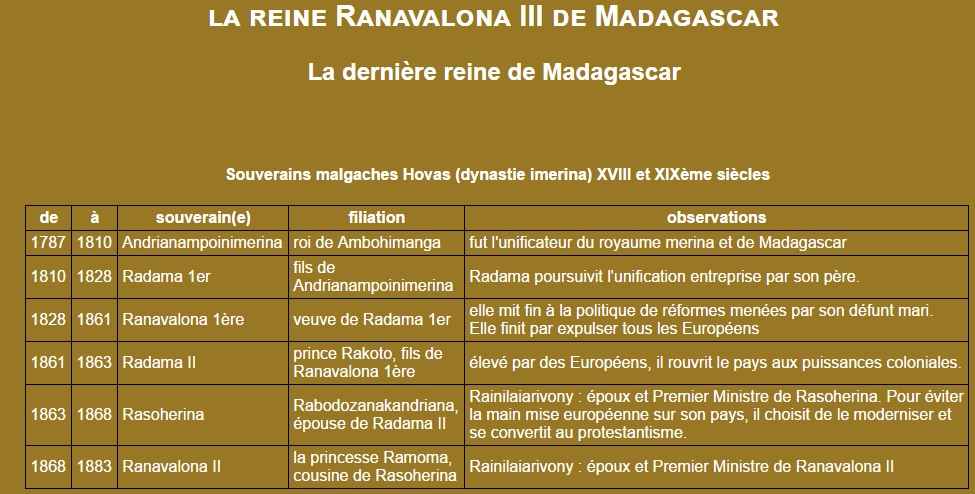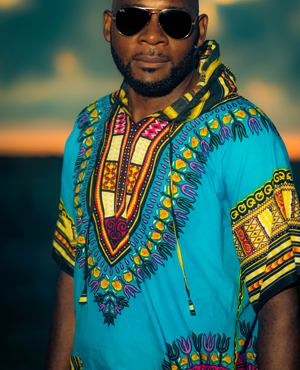Ranavalona III: the last queen of Madagascar
Birth of a queen.
Queen Ranavalona III, named Princess Razafindrahety, was born on November 22, 1861 in Amparibe (former name of the capital of Antananarivo). She was the daughter of Princess Raketaka and Andriantsimianatra and the niece of King Radama II, Queen Rasoherina and Queen Ranavalona II. She was the last Queen of Madagascar from July 30, 1883 to February 28, 1897. Baby, she was entrusted to her aunt, Queen Ranavalona II, who gave her a good education at Protestant missionaries of the LMS (London Missionary Society) Various congregationalist boarding schools. Very young, she was married to a nobleman named Ratrimoarivony, who became her husband. Together, they had a daughter.

Beginning of the reign of Ranavalona III.
In July 1883, on the death of Queen Ranavalona II, she became queen of Madagascar. She is crowned queen, on the day of her birthday, November 22, 1883, under the name of Ranavalona Manjaka III. Following the mysterious death of her husband Crown Prince Ratrimoarivony, for political reasons, she married Prime Minister Rainilaiarivony, a member of the elite Hova, who was previously husband and prime minister of the queens Ranavalona I and Ranavalona II. As Prime Minister of Madagascar, Rainilaiarivony handles the governance of the kingdom and foreign trade policy.
French intervention in Madagascar.
As soon as he enters the throne, the queen has to face the French threat that is trying to invade her island, on the pretext that he wants to help modernize Madagascar. It uses various tactics by improving its trade and diplomatic relations with the United States and Great Britain in order to combat the colonization of French settlers. No longer supporting the invasion of French settlers, the Malagasies rebelled. A civil war broke out between 1883 and 1885. He failed four attempts from France to succeed in colonizing Madagascar, for the Malagasy fought relentlessly. By creating a division between the Merinas and the Menabe Sakalavas, the French succeeded in creating trouble among the people.
The settlers bombarded the coastal port cities of the north and east of the island and seized Tamatave. Then, the colonial navy seized Diego-suarez and proclaimed the island of Madagascar as French protectorate despite the disagreement of Queen Ranavalona and Prime Minister. A treaty was drafted and it compelled Madagascar to pay compensation to France. In order to pay this tax, certain ports are pledged to borrow from the CNEP, and immense wealth is given to the French (logging, copper mining in the country, gold concession in Boina). Not being able to pay taxes, the colonial power in place obliged royalty to multiply taxes and increase the chores of the people.
In 1895, French colonists attacked the Queen’s palace. The French army, under the command of General Duchesne, neutralized all the soldiers of the queen and seized the capital on September 30, 1895. This tragic act signed the end of four centuries of Merina monarchy.
Dismissal of Ranavalona III of Madagascar.
On September 30, 1895, the French Army of Major General Duchesne neutralized the Queen’s soldiers and seized the capital. On his arrival in Madagascar, General Gallieni decided to execute the rebel leaders. He dismissed Prime Minister Rainilaiarivony from office by replacing him with a collaborator from the colonial empire. Prime Minister Rainilaiarivony was arrested and deported to Algeria, where he died the same year.
On August 6, 1896, Madagascar was proclaimed a “French colony” in the National Assembly. At first, the queen remains in power, but she retains only an illusory, purely representative power.
After the capture of Antananarivo, a revolt broke out. It was called the revolt of menalamba (red scarves). The Malagasy nationalist movement fought with all their might, but the French army, better armed, managed to stop them. Accused of having encouraged this movement, the queen was obliged to sign a document by which all the royal possessions belonged henceforth to France. She was first imprisoned in her own palace and held incommunicado.
Then, on the night of 27-28 February 1897, Governor-General Gallieni arrested the queen by surprise. He abolished the royalty of Merina and thus dethroned Queen Ranavalona III, who became the last queen of Madagascar.
General Gallieni explained that she was now “a French subject” and that she, as such, had to pay her respects to the representative of France. Gallieni will forbid her to bear the title of “Queen of Madagascar” by replacing it with “Queen of the Hova“. Following the end of the kingdom of Imerina (now, Madagascar), all Malagasy flags were removed in the country. The former Queen and her whole family will be sent into exile to the island of Reunion and then to Algeria.
Exile of Queen Ranavalona to Reunion and Algiers.
In 1896, Queen Ranavalona III and her whole family were sent into exile to the island of Reunion and then to Algeria. She made several trips to France, including Arcachon.
First, he exiles the queen in La Réunion on 15 March where she finds many leaders of the menalamba resisters who surrendered their weapons. During her journey the queen never ceased to weep, for deep inside her she knew that she never revered her island again. The queen was accompanied by her family, her porters, and some subjects. On arrival in Reunion, a crowd of 1500 to 2000 people were there to welcome him warmly. She remained more than two years in exile in Reunion from March 15, 1897 to November 1898.
Secondly, in 1896, the queen was sent to Algiers with her aunt Ramasindrazana. She is housed in a villa called “Le Bois de Boulogne”, in the district of Mustapha. A good musician, she played the piano and continued to learn French. Unfortunately for her, following the confiscation of all her possessions, the Queen lived in a quasi-poverty in Algiers with the meager allowances that the administration of Gallieni gave him. After the death of General Gallieni, on 27 May 1916, the Queen received better treatment from the French Government. Desiring to visit France and Paris, the Queen made 8 trips to France, where she went to visit Marseilles on May 29, 1901, Paris in June 1901, Arcachon in July 1901, Bordeaux. She was very well received in France. Before leaving the capital, she was received by the President of the Republic, Émile Loubet, and his wife. His most cherished desire was to return to his island in Madagascar, but his wish was never realized until his death.
On May 23, 1917, the last queen of Madagascar died of an embolism, at the age of 56 years. She was then buried in the Saint-Eugène cemetery in Algiers. The “Despatches d’Algiers” wrote the following day:
Yesterday suddenly died Queen Ranavalo in her villa of Mustapha-Superior. In Algiers, she participated in good works and collected many marks of esteem everywhere. “
It was not until September 23, 1938, that his ashes were exhumed to find the land of his ancestors in Madagascar. The remains of the queen were exhumed and transported to the port of Tamatave by the boat “Ville de Reims”. His coffin was transported from Toamasina to the tomb of the queens at the Manjakamiadana Palace in Antananarivo on October 30, 1938. Ranavalona III, the last queen of Madagascar, now rests in the tomb of the queens inside the Manjakamiadana.
Do you know this queen?
































